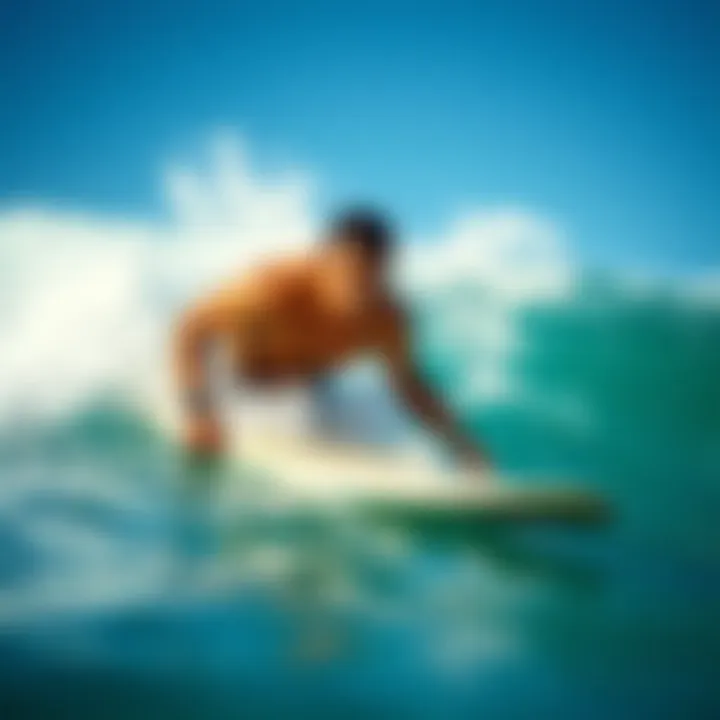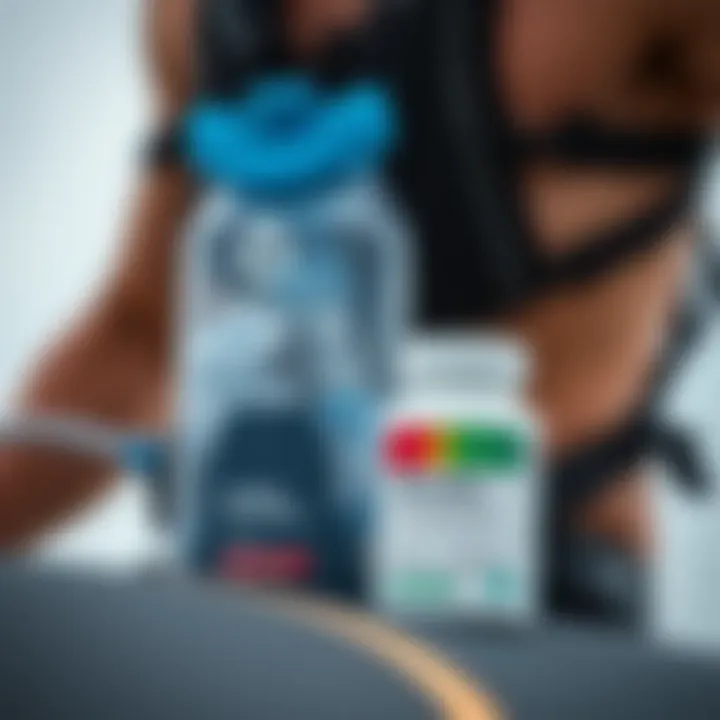Water Cramps: Causes, Symptoms, and Solutions for Surfers


Intro
Cramps are a well-known nuisance, especially for those who spend extensive time in water, like surfers. These painful contractions can catch a seasoned rider off-guard, disrupting not only a wave ride but the entire surfing experience. Understanding what leads to these cramps can play a crucial role in how surfers manage and potentially prevent them.
Water cramps can stem from various factors — ranging from dehydration to over-exertion. Importantly, surfers are often in dynamic environments where their body’s hydration levels and muscular stamina are easily compromised. It's essential to comprehend the physiological underpinnings of these cramps specifically in the context of surfing. Furthermore, proper hydration and nutrition provide the bedrock for optimal performance and enjoyment — two aspects any surfer would surely prioritize.
This guide will navigate through the enigmatic world of water cramps, discussing the underlying causes, hallmark symptoms, and effective strategies for prevention and management. We will also touch on how a balanced approach to nutrition can bolster a surfer's performance.
So roll up your sleeves; we are about to dive into the depths of preventing and managing water cramps amid the waves.
Preface to Water Cramps
Understanding water cramps is critical, especially for surfers and all those who spend substantial time in the ocean. If you’ve ever had that sudden, agonizing tightening of a muscle while attempting to ride a wave, you know exactly what we mean. It’s a pesky problem that can not only interrupt a good surfing session but also pose risks when you’re out in the water.
Water cramps can be a source of frustration, but knowing more about them arms you with the knowledge to cope and take preventive steps. The significance of recognizing cramps is not just limited to their immediate impact— By exploring this topic, surfers will also gain insights into hydration, nutrition, and overall physical fitness, which are intertwined with performance in the surf.
Definition and Relevance
Water cramps, often identified as muscle spasms, typically occur during physical activity—particularly in a wet and demanding environment like the ocean. These cramps manifest as sudden, involuntary contractions of one or more muscles, leading to sharp pain and discomfort. Surfers are particularly vulnerable since they engage in strenuous activity while also contending with cool water temperatures.
The relevance of understanding these cramps goes beyond simply identifying their symptoms. It’s about recognizing the underlying causes which can often tie back to dehydration, improper nutrition, or environmental conditions. By grasping these nuances, surfers can proactively avoid situations that lead to such cramps, enhancing their overall experience when navigating the waves.
Importance for Surfers
Why should surfers care about cramps? Well, firstly they can be a real game-changer at sea. When you're battling waves, the last thing you want is a cramp sidelining you right when you need to paddle hard. If surfers ignore their body's signals, the consequences can be dire. A sudden cramp can lead to losing balance or even falling off the board when navigating turbulent waters.
Moreover, a big part of riding the waves involves endurance and agility, both of which can be compromised by cramps. Understanding their potential triggers helps surfers tailor their diets and hydration strategies.
Some key points to consider include:
- Hydration Levels: Keeping hydrated is vital in minimizing the risk of cramps.
- Warm-Up Routines: A proper warm-up can increase blood flow and flexibility.
- Diet: Consuming the right nutrients before heading into the water ensures muscle function is optimized.
In summary, delving into water cramps is significant not just for immediate pain management, but also for advancing a surfer's overall performance and safety. Embracing the knowledge around cramps translates directly into better enjoyment on the water and healthier surfing habits.
Physiology of Cramps
Understanding the physiology of cramps is crucial for surfers, as it sheds light on the mechanics of muscle functionality during prolonged physical activities. Water cramps not only hinder performance but can also lead to dangerous situations in open waters. Surfers should know how their muscles respond and the patterns of fatigue that can precipitate cramps. This section offers insight into how the body operates under exertion and emphasizes the significance of maintaining muscle health and performance in aquatic environments.
Muscle Function and Fatigue
Muscles function through a complex interplay of biochemical processes that allow for movement, stability, and endurance. When you catch a wave, the muscles in your arms, legs, and core are put to the test. Each muscle contraction depends on the availability of energy and proper hydration. The primary source of energy comes from adenosine triphosphate (ATP). When ATP levels drop due to extended use without replenishment, muscles start to fatigue.
Fatigue is where the trouble begins. A fatigued muscle is more likely to cramp. Typically, after strenuous activity, it’s common to feel tightness or spasms in the affected muscles. For surfers, such fatigue could arise from paddling against strong currents or holding challenging positions while riding a wave. When improperly hydrated, electrolytes such as sodium, potassium, and magnesium become unbalanced, exacerbating muscle fatigue and increasing the likelihood of cramps.
Keeping muscles well-oxygenated and nourishing them post-exercise is vital. Stretching before and after any surf session can help maintain flexibility, reducing the chances of cramping.
Causes of Water Cramps


Water cramps can be attributed to various factors, and knowing them allows surfers to take preemptive measures. Common culprits include:
- Dehydration: Not taking in enough fluids while surfing can lead to cramps. Water loss from sweating and exertion, combined with saltwater, can strain the body.
- Electrolyte Imbalance: Surfers often overlook the importance of electrolytes. Low levels of sodium or potassium due to excessive sweating can lead to muscle spams.
- Inadequate Conditioning: Muscles that aren’t properly conditioned for the demands of surfing are more prone to cramping. This underscores the need for a well-structured exercise regimen.
- Environmental Factors: Cold water can shock the muscles, leading to cramps. Similarly, sudden changes in water temperature can impact muscle function, making surfers more susceptible to cramps.
"Those who understand how their bodies react in the water are less likely to encounter unexpected issues like cramps."
By focusing on muscle care, nutrition, and hydration, surfers can continue to enjoy the waves without the nagging concern of cramps.
Symptoms of Water Cramps
Understanding the symptoms of water cramps is crucial for surfers and anyone engaging with aquatic activities. Knowledge of these physical manifestations can provide early warnings to take preventative measures or seek assistance. Surfers, often caught up in the thrill of catching waves, may not always recognize the onset of cramps until they're deeply entrenched in discomfort. Therefore, awareness can make the difference between a minor inconvenience and a significant setback in performance or enjoyment.
Physical Indicators
Physical symptoms of water cramps typically present themselves as sharp, involuntary contractions of the muscle, often occurring in the legs, feet, or abdomen. These cramps can strike suddenly and usually feel like a tight knot forming within the muscle. It's not uncommon to see surfers temporarily immobilized by a cramp, finding it hard to move or paddle effectively.
- Location: The most affected areas are usually the calves, thighs, and hamstrings. However, cramps can also affect the abdominal area if the core muscles are overstressed.
- Intensity: Initially, the pain might be manageable, but it can escalate quite quickly, leading to severe discomfort. Some surfers describe it as if the muscle is being tightly squeezed and constricted.
- Duration: Cramps can last anywhere from a few seconds to several minutes. After the cramp eases, soreness may linger for a short time.
Recognizing these indicators is key. A tight muscle during or after vigorous activity should not be ignored. It’s the body’s way of signaling that something is amiss, often due to fatigue or strain.
When to Seek Medical Attention
While most cases of water cramps can be managed easily, it's essential to know when the situation escalates beyond regular cramps. If a surfer experiences prolonged cramping or if the muscle remains painful after the initial episode, it may be time to consult a physician. Here are some indicators that signal the need for medical advice:
- Persistent Pain: If muscle pain doesn't subside after stretching or massage and worsens, it may require professional evaluation.
- Swelling or Bruising: Any visible swelling or bruising near the cramping area can indicate a more serious injury, potentially requiring medical intervention.
- Recurrent Episodes: If cramps occur frequently during or after water activities, it could hint at underlying issues such as dehydration or electrolyte imbalances.
- Accompanying Symptoms: Additional symptoms like dizziness, weakness, or changes in vision can be serious and should prompt immediate medical assistance.
It's always better to err on the side of caution. Seeking timely medical advice can prevent further complications and ensure a safer surfing experience.
Being aware of these nuances can help surfers manage their physical health more effectively. Prevention and early intervention can pave the way for a more enjoyable and safer time riding the waves.
Contributing Factors for Surfers
Understanding the contributing factors of water cramps is essential for surfers who want to maximize their performance and minimize discomfort during their time in the waves. Cramps can be a significant hindrance, causing everything from interrupted sessions to potential safety issues. Surfers must be aware of the risks associated with dehydration, nutritional influences, and environmental conditions that can exacerbate these painful muscle contractions. Let’s delve into each aspect and see how these factors interrelate with our aquatic activities.
Dehydration Risks
Water, though abundant in the ocean, is not the same as hydration for the body. Dehydration is a silent enemy for surfers. When your body loses more fluids than it takes in, it becomes a breeding ground for cramps. Sweat loss during intense paddle sessions can lead to significant dehydration before you even realize it.
- Signs of dehydration include:
- Why is this risky? When you’re dehydrated:
- Dry mouth or thirst
- Fatigue or dizziness
- Decreased urine output
- Your muscle function diminishes.
- The balance of electrolytes shifts, increasing the likelihood of cramps.
Surfers need to drink water or electrolyte-rich fluids before, during, and after their time in the sea. Just because you’re surrounded by water doesn’t mean you should neglect your hydration needs.
Nutritional Influences


Food is fuel, and nutritional choices play a pivotal role in muscle performance. Lack of essential nutrients can lead to muscle cramps, especially in high-impact sports like surfing. Your diet influences not just energy levels but also muscle recovery and overall health.
Some important nutrients to consider include:
- Electrolytes: Sodium, potassium, and magnesium keep the muscles functioning smoothly. Low levels can lead to spasms.
- Carbohydrates: They provide the energy needed to keep you surfing for hours.
- Proteins: Crucial for muscle repair after a taxing session.
By eating a balanced meal rich in these nutrients before heading out, surfers can set themselves up for success. Incorporating foods like bananas (for potassium), nuts (for magnesium), and whole grains can boost endurance.
Environmental Conditions
The ocean is a lively and unpredictable arena. Environmental factors can also play a crucial role in the onset of cramps. Understanding how conditions like temperature, ocean currents, and wave action interact with your body can help mitigate risk.
- Heat and Humidity: Hot days can lead to increased sweat and, hence, a greater risk of dehydration. Even if the water feels cool, don’t underestimate the sun’s impact.
- Cold Water: On the other hand, colder water can lead to muscle tightening, causing cramps.
- Overexertion: Surfing in tough conditions, like strong currents or massive waves, can lead to muscle fatigue much faster than normal.
"Being aware of your surrounding conditions can aid in crafting a safe surf experience. Checking the weather, water temperature, and tides is as vital as practicing your paddling technique."
Prevention Strategies
Preventing water cramps is crucial for surfers and water enthusiasts alike. Understanding these strategies forms the backbone of enjoying a day on the waves without the nagging worry of muscle spasms. Cramps not only disrupt your time in the water, but they can also lead to more serious situations if not managed appropriately. Here are the essential strategies you should consider.
Hydration Techniques
Water is the lifeblood of our bodies, especially under the sun and the force of the waves. Staying adequately hydrated is one of the most effective ways to stave off cramps. Here are some hydration techniques to integrate into your pre-surf routine:
- Drink Regularly: Aim to sip water consistently throughout the day rather than gulping large amounts at once. This helps your body maintain an even level of hydration.
- Electrolyte Balance: Water alone isn't enough. Consider drinks that replenish electrolytes like sodium, potassium, and magnesium. Products like Gatorade or coconut water can be handy.
- Pre-Surf Intake: Have a glass or two of water an hour before you hit the water. This gives your body time to absorb it effectively.
Adhering to these hydration techniques will not only help prevent cramps but also improve your overall performance.
Warm-Up and Stretching
Getting your muscles prepped for action can make all the difference in the world. A well-rounded warm-up routine that includes stretching is essential. Here’s what to keep in mind:
- Dynamic Stretching: Focus on dynamic stretches like arm circles and leg swings to get the blood flowing. Static stretching post-surf works for recovery, but before? Dynamic is the name of the game.
- Target Specific Muscle Groups: Pay special attention to the muscles you know you’ll use the most. Hamstrings, quadriceps, and calves are all likely suspects for cramping.
- Routine Practices: Establish a warm-up routine you can follow before each surf session. This repetition helps condition your body to the demands of surfing.
Integrating these stretching and warm-up techniques can significantly lower the risk of cramps.
Nutrition Best Practices
What you put in your body matters, especially when engaging in intense physical activities like surfing. Following good nutrition practices can directly influence muscle function and hydration status. Consider these tips:
- Balanced Diet: Include a variety of carbohydrates, proteins, and fats. Foods rich in complex carbs, like whole grains, give you sustained energy.
- Banana Power: Bananas are packed with potassium—an essential nutrient for muscle function. Having one before surfing can work wonders.
- Timing is Key: Avoid heavy meals immediately before surfing. Instead, snack on something light and nutritious about 30 to 60 minutes beforehand.
Incorporating these nutritional practices into your routine can be a game changer for performance and stamina.
"Prevention is better than cure." – This ancient saying rings particularly true in the context of water cramps. By preparing your body properly, you minimize the risk of cramps and maximize your enjoyment on the water.
Management of Water Cramps


Effective management of water cramps is crucial for surfers and those who spend extended periods in aquatic environments. Recognizing how to handle cramps not only alleviates discomfort but also plays a significant role in enhancing performance, safety, and overall enjoyment in the water. Surfers, with their dynamic physical exertion amidst changing currents, can benefit profoundly from strategies aimed at mitigating cramps, ensuring they stay in top form while riding waves.
Immediate Relief Techniques
When cramps strike, the first response is often a scramble for relief. Immediate techniques can be the difference between a minor annoyance and a potentially dangerous situation. Here are some practical methods to relieve cramps:
- Stretch the Affected Muscle: Gently elongating the muscle in spasm can work wonders. For a calf cramp, try standing on a flat surface, then slowly and carefully flex your foot upwards.
- Massage: Use your hands to apply firm pressure to the cramping muscle. This not only alleviates the spasm but also increases blood flow to the area, aiding recovery.
- Hydration: Drink water or electrolyte-rich fluids, particularly if you suspect dehydration is a contributing factor. The balance of electrolytes helps muscles function properly.
"Sometimes it’s not just about making a splash; it’s about ensuring you can keep surfing for hours on end."
- Warm Compress: If conditions allow, applying a warm compress to the cramped area can help relax the muscle and ease the pain.
- Cool Down: Post-exertion, it's good practice to transition from high activity to low gradually. This can prevent sudden cramps and ensure your body has time to recalibrate.
Post-Cramps Recovery
Once the immediate crisis has passed and the cramping has subsided, it's essential to focus on recovery. How you treat your body post-cramp is just as important as the relief tactics used during the episode. Here are some strategies for recovery:
- Rest the Muscle: Do not jump right back into the action. Give the affected muscle a chance to recover. Light stretching or gentle movement can help, but avoid strenuous activity until you feel fully restored.
- Rehydration: Continue to hydrate. Consider drinks with electrolytes. This maintains the balance that is essential for muscle health.
- Nutrition: Eating a well-balanced meal after severe physical activity can replenish lost nutrients. Foods rich in potassium and magnesium, like bananas and nuts, can be particularly beneficial in preventing future cramps.
- Reflect on Technique: After experiencing cramps, review your surfing techniques and overall training routine. Sometimes, cramps can be a signal that your body is pushing too hard without adequate preparation.
- Regular Stretching Routine: Implement a regular pre- and post-surf stretching routine to maintain flexibility in your muscles. This practice can significantly reduce your risk of cramps in the future.
Understanding and applying these management strategies will not only prepare surfers to handle cramps when they arise but also contribute to better overall physical conditioning and enjoyment in the water.
Long-Term Considerations
Long-term considerations regarding water cramps are paramount for surfers, not only for enhancing performance but also for ensuring overall well-being in the water. These considerations involve understanding how to build physical capabilities over time and recognizing the body's signals that indicate when to adjust activities or practices. By adopting a proactive approach, surfers can significantly reduce the risk of encountering cramps during their time in the sea.
Building Stamina and Strength
When it comes to battling water cramps, building stamina and strength is not just optional, it's essential. Surfers who engage in regular, structured training often notice fewer instances of cramps. The reason behind this is simple: stronger muscles are less prone to fatigue.
To develop better stamina, incorporating cardiovascular exercises into your routine can prove beneficial. Here are some options:
- Swimming: This enhances both lung capacity and muscle endurance. It mimics the resistance of the water that surfers face.
- Cycling: Offers a good cardiovascular workout without the strain of running.
- Running: Helps to build leg strength and overall endurance, which translates well into surfing.
Additionally, strength training focusing on core and leg muscles can provide necessary power and support.
A basic routine may include:
- Squats: for leg strength
- Planks: to enhance core stability
- Resistance bands: excellent for building overall muscle endurance without heavy weights
Consistency is key. Aim to gradually increase the intensity and duration of these workouts to enhance resilience. Over time, as your stamina builds, you’ll find your body can better handle extended time in the water, reducing the likelihood of cramps.
Monitoring Body Signals
Listening to your body is a critical aspect of long-term management of water cramps. The body often gives subtle signals before cramps become a problem. Here are some things to keep an eye on:
- Fatigue Levels: Feeling unusually tired? This could be an indicator to take a break.
- Hydration Indicators: Dark urine is often a sign that you need to hydrate. Regularly sip on water, especially in hot conditions.
- Muscle Tensions: Any tightness or discomfort can be your body warning you. It’s better to stretch or ease off rather than push through pain.
- Nutrition Needs: Sometimes, a lack of key minerals like potassium or magnesium can cause muscle spasms. Monitoring your diet and possibly adjusting your intake might stave off issues associated with cramps.
"An ounce of prevention is worth a pound of cure" - this age-old saying rings true in the world of surfing. Proactively managing your body’s signals not only enhances your time on the waves but safeguards against future cramps.
Epilogue
Water cramps pose a notable risk for surfers, impacting not only comfort but also safety while riding waves. It’s crucial, therefore, to shed light on management and prevention strategies. Understanding the physiological factors that lead to these cramps is the foundation upon which effective practices can be built. Remember, hydration isn’t just about drinking water. It incorporates balanced nutrition as well, taking into account electrolytes that the body loses during prolonged activity in aquatic environments.
Recap of Key Points
- Definition and Relevance: Water cramps occur when muscles involuntarily contract, causing sudden pain, particularly relevant for surfers who face these while paddling or maneuvering.
- Causes and Symptoms: Factors such as dehydration, muscle fatigue, and inadequate nutrition are primary contributors to water cramps. Symptoms include sharp, sudden pain in the affected muscle, often requiring immediate attention.
- Prevention Strategies: Proper hydration techniques before and during surf sessions and stretching exercises can greatly decrease the likelihood of cramps. Paying attention to dietary needs is also vital to support muscle function.
- Management Techniques: Immediate steps, such as relaxation and gentle stretching of the cramped muscle, are essential. Post-cramp care should focus on rehydration and nutrient replenishment.
- Long Term Considerations: Building muscle strength and stamina can mitigate the frequency and severity of cramps. Monitoring one’s body, recognizing triggers, and being proactive is fundamental for performance enhancement.



